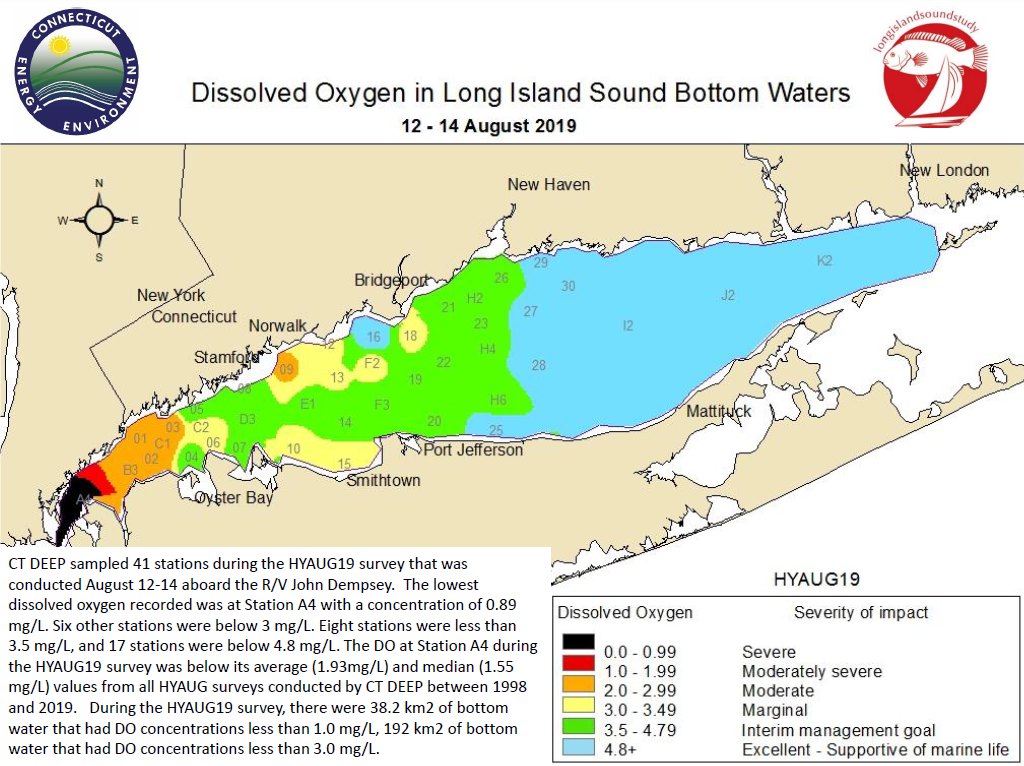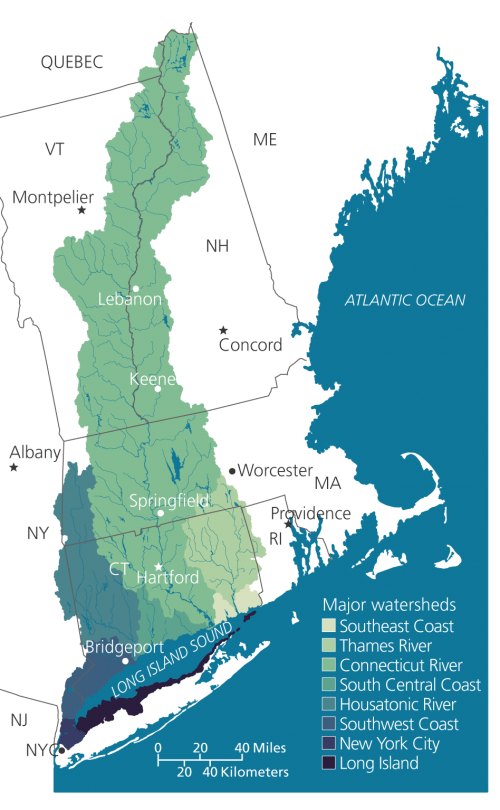Implementation of Long Island Sound Nitrogen Strategy Upheld by EPA’s Environmental Appeals Board This Spring
Roger Reynolds, Senior Legal Counsel, updates us on a major step forward to fully restore Long Island Sound:
A new nitrogen limit imposed on the Springfield Water & Sewer Commission (Springfield) and other Massachusetts sewage plants represents a significant victory in Save the Sound’s decades-long campaign to eliminate dead zones in Long Island Sound by reducing nitrogen discharges. In late May, the EPA’s Environmental Appeals Board upheld the agency’s decision to impose a 5 mg/L limit on nitrogen based upon the Springfield plant’s capacity.
This limit was the result of years of legal advocacy by Save the Sound, CT River Conservancy, and CT Department of Energy and Environmental Protection and is part of a broader vision to eliminate nitrogen fueled dead zones from Long Island Sound. It also upholds and affirms the critical principal that the Clean Water Act prohibits any discharges that are imperiling the health of a waterbody, and such mandates can override older regulatory schemes such as the 2000 Long Island Sound Total Maximum Daily Load (TMDL) Plan that may be outdated and no longer protective.

Nitrogen Induced Low Oxygen and Dead Zones in Long Island Sound
When too much nitrogen is discharged into Long Island Sound it creates low oxygen conditions, known as hypoxia, making it harder for aquatic life to survive. In some instances excess nitrogen creates zero oxygen zones, also known as dead zones. Some other impacts are toxic algal blooms, low dissolved oxygen, poor water clarity, loss of aquatic vegetation and tidal wetlands, as well as coastal acidification. Sewage treatment plants throughout the Long Island Sound watershed are the primary drivers of low oxygen and dead zones in the Sound. Other sources that contribute are stormwater runoff, fertilizers, and poorly performing septic systems.
The Total Maximum Daily Load Plan was issued in 2000 to limit the amount of nitrogen discharged to Long Island Sound and begin to bring it back to health. This took the preliminary step of requiring nitrogen reductions from Connecticut and New York sewage treatment plants by almost 60 percent by 2014. This goal has now been largely achieved and has made the dead zone in Western Long Island Sound significantly smaller, but has not eliminated it. Moreover, new nitrogen based pollution challenges have emerged in our bays and harbors.
Save the Sound’s 2015 Nitrogen Petition
Thus, in 2015 (when the actions identified in the 2000 plan were supposed to have been achieved), Save the Sound—joined by CT River Conservancy, Rivers Alliance of Connecticut, and others—petitioned EPA to create a new plan to further reduce nitrogen discharges and bring Long Island Sound back to full health. We argued that Long Island Sound continues to violate federal water quality standards and that the next step will need to extend beyond New York and Connecticut to Massachusetts, Vermont, and New Hampshire—states which contribute nitrogen to Long Island Sound through the Connecticut and Housatonic Rivers. Future plans will also have to extend beyond consideration of the Western Long Island Sound dead zone and address localized low oxygen zones and dead zones that exist in our bays and harbors throughout the Sound.
Shortly after we filed our petition and before ruling on it, EPA announced a far-ranging “Nitrogen Strategy for Long Island Sound,” which sought to achieve many of the goals we advocated for in the nitrogen petition. It set out three large goals to:
- further reduce the dead zone in Western Long Island Sound by further sewage plant reductions from the New York City area,
- reduce low oxygen zones and dead zones in our bays and harbors through localized action, and
- reduce nitrogen pollution entering Long Island Sound via major rivers such as the Connecticut and Housatonic.
Each one of these strategies would involve:
- characterizing how much excess nitrogen is contributing to the problem,
- determining the sources of nitrogen, and
- setting reduction targets for specific sources to achieve waterbody health.
Given EPA’s stated intention to fund and move forward with the Nitrogen Strategy, Save the Sound and our partners held the petition in abeyance pending the implementation of the strategy. While full implementation of the Strategy has not happened as fast as we would have liked, significant progress has been made on all three fronts by reducing New York City discharges into the western dead zone, creating plans for harbors and bays, and addressing pollution from the upper Connecticut River.

The Springfield Permit Limits Address Pollution Coming from the Connecticut River to Long Island Sound
The Springfield nitrogen limits upheld by the Environmental Appeals Board represents progress in controlling the huge amounts of nitrogen entering Long Island Sound and the dead zone from the upper Connecticut River. It has been estimated that 1,776.7 metric tons per year (or 10,820 pounds per day) of total nitrogen was discharged to the Connecticut River, and eventually Long Island Sound, from Massachusetts, Vermont, and New Hampshire.
EPA originally sought a far weaker approach in its first draft permit, favored by Springfield, that Springfield “optimize” nitrogen treatment. This basically means they would do their best but there would be no actual limit placed on nitrogen. Save the Sound, along with CT River Conservancy and CT DEEP, testified in opposition to this and argued that a real limit had to be imposed due to the impact on Long Island Sound. In their final Response to Comments, EPA agreed and imposed a 5 mg/L limit on Springfield, and also imposed a number of other limits derived from the same method on other Massachusetts sewage treatment plants. The final limit issued to Springfield and other Massachusetts plants is calculated to stop any increases in nitrogen loading to Long Island Sound. However, it is more significant in that there will be nitrogen limits and controls in place. Once EPA completes the work of calculating nitrogen loads for Long Island Sound, the limits can be adjusted downward to meet the target.
Springfield challenged the permit limits by appealing to the Environmental Appeals Board, arguing, among other things, that the limits were not justified, not scientifically backed, and not within EPA’s authority to issue. Save the Sound, CT River Conservancy, and CT DEEP all filed amicus briefs supporting the limits and arguing they represented the minimum necessary to protect Long Island Sound. In a nearly 100-page opinion, the Environmental Appeals Board upheld the limits, categorically denying all of Springfield’s arguments. Most notably, the Appeals Board found that the 2000 TMDL Plan did not constitute a ceiling on protections for Long Island Sound but did constitute a floor. That is, the mandate to set limits that will be protective of water quality override specific limits included in these plans. This is exactly what we had argued in our 2015 nitrogen petition and this will be instrumental in being able to advocate for, and achieve, meaningful limits that will fully restore Long Island Sound.
The Next Steps
Springfield may seek to appeal the decision to the First Circuit Court of Appeals. If they do so, we will file an amicus brief in those proceedings reiterating our arguments. We are confident that the Environmental Appeals Board decision was well reasoned and will be upheld, and will stay vigilant to protect the Sound’s and the Connecticut River’s waters from nitrogen pollution.
